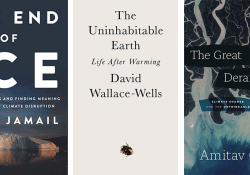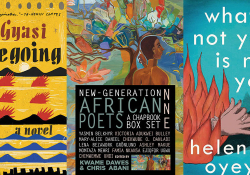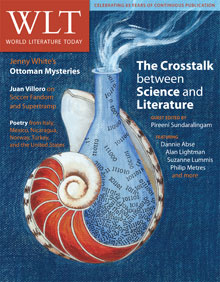Science and Poetry: Predation or Symbiosis?
Are science and poetry inherently at odds with one another? Poet
and cognitive scientist Pireeni Sundaralingam explores the nature
of interactions between these two disciplines.
Journeying through the pantheon of forms that make up life on this planet, we encounter a host of different relationships between species; while there are those that hunt each other down for food, there are also those that only feed off the decaying material of other organisms, and yet others whose interdependent behavior increases their joint chances of survival. Although our current culture tends to treat science and poetry as if they were mortal enemies, we may develop a better understanding of the complex interconnections between these two disciplines if we consider them, instead, in terms of the variety of relationships that have evolved between species in the organic world.
Let’s start by examining the argument that poetry has a purely parasitical relationship with regards to science. Certainly, we currently see a proliferation of poems ingesting the most accepted findings of scientific research, and in their place excreting simplified redescriptions with a hushed sense of wonder. Such praise poems exhort us to dwell on the numerosity of Saturn’s rings, to consider the relationship of tadpole and frog. It is true that such writing celebrates science, but like the rheumy-eyed distant relative at family gatherings who insists on redescribing the moon landing, their insights smack of humdrum platitudes, drummed up simply to demand attention, or worse a quick dollar. These are poems that, ever with an eye to the main chance, would happily resell us London Bridge. They are poems that seem to do a better job of celebrating themselves rather than science, limping behind the other discipline with a terrible sense of dependency. They rarely engage with the cutting edge of scientific theories or dare to reenvision scientific data with fresh metaphors. They absorb the language and images of science, but little is given back in return.
There are, however, more positive ways in which poets can be said to feed off the body of science. Numerous poets have turned to the words and images of science to provide them with new metaphors as they struggle to understand nonscientific domains. Thus, in her poem “Autotomy,” Wisława Szymborska appropriates the image of the holothurian (the sea cucumber) and that, when attacked, it splits into two as a defense mechanism. The poem explores the way in which one’s life and one’s writing lead distinct existences while questioning whether either may ever really survive for long given the surrounding dark. Szymborska is just one of a fine tradition of poets mining scientific findings for their own ends. Coleridge attended science lectures given by Humphrey Davy at the Royal Institution in order, he claimed, to “renew my stock of metaphors.” Keats, having completed six years of medical training, seemed happy to parlay the images of his textbooks to serve his poems. Writing at a time when research in neuroanatomy was revealing an array of hithertofore undreamed of structures, the poet sprinkled his own creative writings on identity and memory with allusions to delicate branches and spreading networks, as Ann Townsend has noted in her analysis of such Keatsian works as “Ode to Psyche.”
There are, of course, counterclaims that it is in fact science that preys on poetry, if not directly, then at least indirectly, like the eucalyptus whose leaves decompose into toxins, preventing the growth of other species in its vicinity. The assumption that science annihilates poetry, by destroying the environment in which it thrives, takes on several forms. First, there is the belief that science promulgates an intellectual hegemony, imposing a singular way of thinking that stifles all alternative methods of discourse, including poetry. Scholars such as Jane Rupert caution us that “the tyranny exercised by the method of empirical science and a philosophy of mind that dismisses the legitimacy of other modes of reasoning have led to an increasing atrophy of equally honorable modes of thought.” Poets such as Czesław Miłosz lament that “[poets] . . . become the voice of the universal human longing for liberation from what is cold as two times two is four, harsh and pitiless.” Such critics perhaps overlook the fact that poetry itself may equally be used to limit true forms of intellectual inquiry. In his memoir If This Is a Man, Primo Levi notes that the Italian poetry of his youth was so resolute in propounding the propaganda of the Fascist regime that it stifled the possibility of all alternative ideas. It forced Levi and large numbers of his contemporaries to find creative refuge amid mathematics and the sciences, the only place where there was still room for intellectual freedom.
Second, there is the belief that science’s reductionist framework leaves no room for wonder. At one point in his sprawling work Jerusalem, Blake denounces the rationalistic stance of Bacon and Newton, blaming them for the demise of spiritual beauty:
For Bacon and Newton, sheath’d in dismal
steel, their terrors hang
Like iron scourges over Albion; Reasonings
like vast Serpents
Enfold around my limbs . . .
Yet for every poet ready to denounce science for “unweaving the rainbow,” there have always been others who have championed its cause. Wordsworth and Sheridan waxed lyrical regarding the scientific breakthroughs of their time, and Blake himself, at the end of Jerusalem, envisages heaven as a place where Bacon and Newton stand beside Shakespeare and Milton. Those who claim that science and poetry are diametrically opposed tend to argue that in attempting to explain the world around us, science robs it of its mystery. Yet it is science that calculated that the light emanating from Polaris, the North Star, started its journey before Shakespeare first set pen to paper. Far from stripping the world of its wonder, we watch scientific discoveries demonstrating that even the most mundane structures are such stuff that dreams are made on, from the dark energy of space to the repeating codes within our cells. If poetry is about making the familiar unfamiliar, as Shelley argued, then it is not so far from the best of science.
Third, there is the popular belief, at least within Western culture, that the spirit of poetic imagination is inevitably destroyed by the sterility of the “cold,” quantitative, formal methods of science. Yet such complaints do not compare like with like. They pit methodology against creativity, discipline against inspiration, as if science were devoid of paradigm-shifts and lateral thinking and as if poetry floated free of the careful practice of craft. While science may draw on assiduous observation, careful note-taking, and a fine attention to detail, it simultaneously relies on embracing novel metaphors and innovative models in order to advance. Thus, Evangelista Torricelli’s research, summed up by his radical premise in 1644 that “we live at the bottom of an ocean of the element air,” helped catalyze not just a surge of pioneering studies in barometry and chemistry but also instigated the rethinking of the nature of blood pressure and ultimately led to radical advances in the understanding of the circulatory system. Conversely, the literatures of many cultures can provide us with clear examples of the rigor and regularity with which poetry may be written, despite the fact that it is not uncommon to see the careful measurement of iambs and attention to the details of internal rhyme duly pilloried in certain contemporary American journals. (It is interesting to note that the same language that is used to insist that science destroys poetry’s “natural” environment is all too often used to criticize the methods of formal poetry as well.)
In evaluating the connection between poetry and science, we need not be confined to models of resource competition or parasitism, however. A closer look at the organic world yields up several examples of distinct species living together in mutualistic symbiosis. Consider lichen. Here are two species so closely intertwined that, as in the case of the cyanobacteria living within fungi, they are considered to be one organism: the algae engage in photosynthesis, using sunlight to turn simple sugars into more complex compounds that can be used by both species, while the surrounding fungus draws on its extensive system of threadlike hyphae to bring a wider range of minerals to the algal cells than they could access by themselves.
Looking beyond contemporary Western cultures, we find numerous examples of mutually beneficial relationships existing between science and poetry. The Roman poet Lucretius captured the groundbreaking ideas of the Greek atomists—that all objects in the physical universe must be constituted of indivisible particles, invisible to the human eye, moving randomly in an infinite void—in vibrant hexa-meter. Not only did Lucretius explicate the basic hypotheses of the atomist theory, his vivid lines portrayed these early scientific ideas so powerfully that they lingered in the human collective memory and imagination for centuries. It took nearly two thousand years for data to arrive to prove these hypotheses, but in the meantime, the theory had been preserved and propounded through the language of poetry. To cite another example, scholars in ancient India expounded the scientific ideas of their time at court through carefully paced metric verses such as the Rasayana, Bhautika, and Jeeva shastras, which dealt respectively with the principles of chemistry, physics, and biology (the Rasayana shastra describes the multiple uses of prepared forms of mercury as well as numerous other pharmaceuticals). Similarly, The Loves of the Plants (1789), Erasmus Darwin’s two-thousand-line poem, uses poetry as a vehicle through which to set out the scientific ideas of the time. In this particular case, Darwin explicitly aimed to explain the revolutionary ideas of Linnaeus to the general public through the use of evocative imagery and the heroic - couplet form.
We should note that poetry may go beyond simply describing scientific theory, however; it may also be a rich source of data. In certain cases, poetry allows scientists to cast their net wider, like the algae within the fungus, gathering in data they might otherwise have difficulty accessing. In more than a few instances, poems may provide the type of case study evidence that instigates subsequent experimental exploration by scientists. For example, field biologist Gary Nabhan argues that the historic song-poems created by the medicine men of the O’odham peoples codified the hallucinogenic properties of those chemicals naturally occurring in the datura plants, recording first-hand accounts of the effects of the drugs on both humans and other species. Eight decades after these poems were first published, neurobiologists are now systematically analyzing the psychotropic mechanisms first laid out in the poetry of the Sonoran desert.
A more contemporary example of the interplay between science and poetry comes from the emerging field of neuroaesthetics. Here, pioneering scientists such as V. S. Ramachandran are exploring the uncharted territories of the human brain, using the tools of metaphor and imagery rather than scalpel and electrode to assess the functional boundaries of the living neocortex. In examining cross-sensory metaphors commonly used in everyday English, Ramachandran points out that, in terms of poetry, not all senses are created equal: while certain pairings of senses work in poetic phrases, others clearly do not. As an example, tactile adjectives are commonly used to describe taste sensations, but adjectives from the world of hearing are rarely mapped onto taste. Thus, we find it acceptable to refer to cheese as “sharp” but would never say it was “loud.” On the other hand, we find it quite acceptable to refer to the visual pattern of a shirt as “loud.” Ramachandran argues that such linguistic patterns may reflect the fact that there is more substantial neural wiring linking the cortical areas that process touch and taste, or sound and vision, than there are between the areas that process taste and sound. It has been found, for example, that the insular cortex (responsible for receiving incoming taste signals) lies in relative proximity to those cortical areas which process touch information. Poets will no doubt find it edifying that Ramachandran suggests that there is even a possibility that those skilled at forming metaphors, artists fluent in pairing together unrelated objects or ideas, may enjoy an enhanced “hyperconnectivity” throughout their cortexes.
The study of metaphors is undoubtedly becoming a burgeoning component of cognitive science and one future path where poetry and science may converge healthily in the future. In his Poetics, Aristotle asserted that to master metaphor is “a sign of genius, since a good metaphor implies an intuitive perception of the similarity of the dissimilar.” Certainly, contemporary cognitive scientists such as Lakoff and Johnson argue that our use of metaphorical language lies at the root of human abstract thinking. They point out that we grasp abstract ideas such as time, morality, and rationality by mapping them onto a framework of spatial relations; we use our knowledge of the physical world as a metaphor through which to reason about other domains. For instance, Lakoff and Johnson point out that when we discuss morality, the phrases we use (such as “He is high minded”; “She is an upright citizen”; “He fell into an abyss of depravity”) all describe virtue as higher in spatial terms and immorality as lower, even though there is no intrinsic or logical reason to do so.
Another branch of research in which cognitive scientists are assessing the importance of metaphors in structuring our thought processes is that of “priming” effects. Experimenters such as John Bargh at Yale are finding increasing evidence that under certain conditions, humans find it difficult to distinguish metaphorical versus literal information. Bargh and his colleagues have demonstrated that when people are required to evaluate something, their judgments can be significantly influenced, or primed, by being exposed to an unrelated physical sensation if that sensation is significant in metaphorical terms. Thus, if the study participant briefly held a warm cup of tea on their way into the testing area, their subsequent judgments of the “warmth” of a stranger’s personality would be significantly enhanced. Similarly, people who were given a heavy clipboard to hold while evaluating a job candidate were more likely to judge that person as having gravitas and weighty opinions. (Note that the heaviness of the clipboard did not affect any other personality component that the participant was evaluating, only those components which had a metaphorical connection with what the participant was physically feeling.) As these experiments suggest, the human brain seems to be easily confused in distinguishing metaphorical versus literal representations. Such findings echo those of other researchers who have shown that both sensory disgust (such as a reaction to foul-smelling food) and moral disgust are processed in the same part of the brain—the anterior insula. This may explain why the images and metaphors we use to describe our sense of moral disapproval are so often couched in the same language we use for our more literal sensory reactions.
Finally, perhaps the most profound symbiosis that can occur between science and poetry occurs when both disciplines come together to solve a common problem. Perhaps the best example of this is in Miroslav Holub’s poem “Hemophilia / Los Angeles,” in which the writer maps the physiological structure of disease onto the network of the city’s freeways. The poem goes beyond simply using one system as a metaphor for the other, however. Instead, it borrows the image of internal elements of urban self-destruction and cycles of pollution to reevaluate the model of disease in a groundbreaking way, asserting the importance of biological cellular death and the recombinations of viral genetic code for the overall health of the multicellular species. Of course, Holub enjoyed the vantage point of being both an award-winning poet and an eminent epidemiologist, but we may hope that a future in which the disciplines of science and poetry begin to be reconciled will allow further examples of such inspired symbiosis to come to light.
San Francisco












